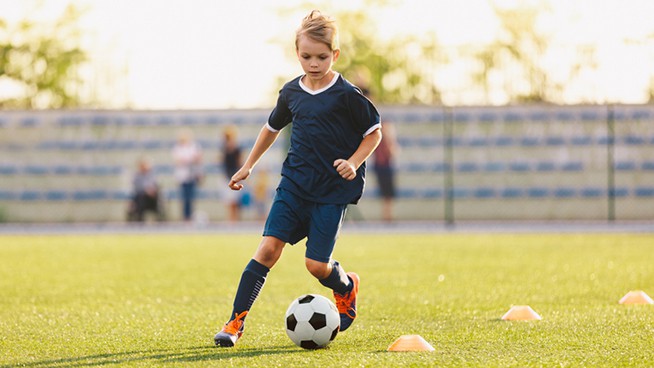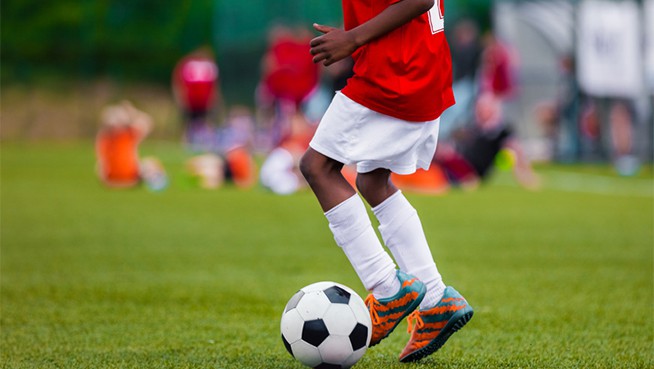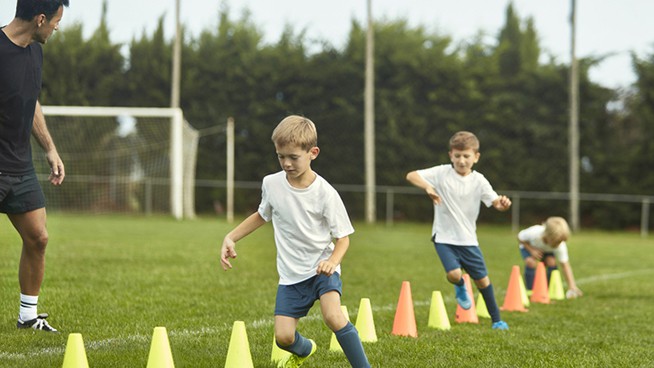Why Agility Is Critical for Soccer Players
Sprinting speed is very important, but soccer isn’t a track meet. It’s not a linear game, and elite soccer players have great agility in addition to blazing straight-ahead speed.
Agility can be divided into two key components—quickness and change of direction. Sprinting speed is great, but if you can’t change direction, you’re going to get burned.
Speed Formula
The Speed Formula doesn’t apply only to linear sprinting. It also applies to multi-directional movements. The motor control may be different, but Newton’s Laws of Motion still apply, no matter what direction you are travelling.
There are differences in how we apply the Formula when compared to sprinting. When we compare BIG FORCE, the magnitude may be different, as might the type of muscle contractions. SMALL TIME and PROPER DIRECTION usually become more important, while OPTIMAL RANGE OF MOTION is usually smaller than in sprinting.
Same scientifically based formula, different types and values going into it.
Quickness
You know the feeling you get watching elite players with incredible quickness? Their movements are crisp, precise and lightning fast, and they keep their bodies in total control.
Lightning-fast movements made in 1 or 2 steps can make all the difference between reacting to an opponent or leaving one on the ground.
When we consider the Speed Formula for Quickness, the emphasis moves away from BIG FORCE and changes to SMALL TIME, PROPER DIRECTION and OPTIMAL RANGE OF MOTION.
Body control and balance are big parts of true athletic quickness. Without them, you are like a fish out of water, flailing ineffectively. Athletic quickness requires that you have the balance to keep your body in control and apply ground reactions forces effectively to move you in the PROPER DIRECTION.
This becomes even more evident in soccer, where many of your moves are made with a ball at your feet. You must have excellent single-leg balance, stability and quickness to apply forces to your body for movement and still maintain good touch on the ball.
It’s important to recognize that when it comes to quickness with your footwork, smaller, not bigger, movements are usually the OPTIMAL RANGE OF MOTION. That’s because you need your feet close to the ground to react and make movements quicker.
The ground reaction force is smaller, but quicker and more reactive. When most people think about strength, they imagine how much someone can lift on a barbell. However, that is only one type of strength. The STACK Velocity Sports Performance methodology uses six strength types to make athletes more effective in the game. Instead of just Speed-Strength Power, we are more focused on developing Rate of Force Development and Reactive Strength.
RELATED: Improve Soccer Agility with Lateral Strength Exercises
Rate of Force Development
This type of strength is all about how fast you can turn on your muscles and generate force. In biomechanics, it’s called Rate of Force Development (RFD).

Player A may be stronger when squatting with a barbell; but since Player B can turn his muscles on quicker, he’ll start moving faster than Player A. As shown above, when it comes to quickness, it’s not how much force you can produce, but how quickly you can produce it.
Physics
If an athlete is already moving one way, he or she has to apply force to re-direct his or her momentum. This is Newton’s First Law of Motion. Paraphrased, an object will keep going in the same direction unless acted on by another force. Exercising agility and quickness, an athlete must apply this other force.
Reactive Strength
During quick agility movements, the foot’s contact with the ground first requires an eccentric muscle action. Eccentric actions occur when the muscle is contracting (trying to pull together its muscle cells) but is being forced to stretch at the same time. This is the muscle exerting force one way to resist the athlete’s momentum.
This rapid eccentric force to change momentum is immediately followed by a high RFD to redirect the athlete. Rapid eccentric force coupled with a high RFD in a small time are what we biomechanically call Reactive Strength.
What You Need
Reactive Strength and RFD
- Single-Leg Hop Back
- Ladder Drills – Backward Single-Leg
Body Control and Dynamic Balance
- Hexagon Agility
- Single-Leg Med Ball
Change of Direction
Soccer isn’t linear; it constantly changes from one part of the field to another. You have to mark a player who is going one direction, then another. As a player, the ability to do this faster and in fewer steps than your opponent gives you an edge.
Physics
If the angle of the change is less than 90 degrees, it’s an obtuse (quick) cut. If it’s more than 90 degrees, it’s an acute (sharp) cut. You want to think about this, because the SPEED formula is a little different for each. As a soccer player, you need to be good at both.
Both types of change of direction are common in soccer. They are among the most demanding actions for your muscles and for your energy systems. They also can make or break key moments. If you can’t shake a defender when attacking, or can’t stay glued to the attacker when defending, you lose.
Quick Cut
The quick cut usually happens at speed. You’re dribbling down the field and want to make a small change to throw the defender off balance or get to an open space. Or, you may be defending a tracking a player as he or she moves across the field. He or she is trying to lose you, and you need to make small cuts to stay with them.
Sharp Cut
Sharp cuts also happen. You’re defending a player with the ball racing in one direction. He or she makes a quick stop, pulls the ball back and goes the other way. You’d better make a fast sharp cut to stay with him or her.
The Formula for Change of Direction
The Speed Formula is different when we consider BIG FORCE and SMALL TIME. The quick cut is just that—quick, meaning the time on the ground is smaller and the angle change (and therefore the amount of force applied) is smaller. This requires Reactive Strength. In the sharp cut, you have to absorb a lot more momentum to stop going one way, then reapply large force to re-accelerate in a new direction. This requires a combination of Eccentric Strength and Speed-Strength.
The Formula is also different in the OPTIMAL RANGE OF MOTION. The sharp cut has to absorb more momentum eccentrically, so the knees and hips will bend more and/or you will take more steps, whereas the quick cut should only see a little bend at the knees and hips.
Improving Change of Direction
Change of Direction is about the physics of momentum. For best results, you need to understand how to apply the Speed Formula properly.
Eccentric Strength
- Kettlebell Swings
- Single-Leg Hurdle Hops and Stick
- Ladder Lowering
Effective Mechanics
- Activate Base Drills
- Inside Box Drill
- Wall Crossover Drills
- Carioca Quickstep
Soccer Agility Makes You A Better Player
True soccer game speed means linear speed and agility. Whether it’s the quickness exhibted with fast footwork and dynamic moves, or rapid changes of direction, you can’t be lacking. These are skills that can be trained through better movement mechanics and by improving the right physical qualities. Take control of your game speed and improve to succeed.
RECOMMENDED FOR YOU
MOST POPULAR
Why Agility Is Critical for Soccer Players
Sprinting speed is very important, but soccer isn’t a track meet. It’s not a linear game, and elite soccer players have great agility in addition to blazing straight-ahead speed.
Agility can be divided into two key components—quickness and change of direction. Sprinting speed is great, but if you can’t change direction, you’re going to get burned.
Speed Formula
The Speed Formula doesn’t apply only to linear sprinting. It also applies to multi-directional movements. The motor control may be different, but Newton’s Laws of Motion still apply, no matter what direction you are travelling.
There are differences in how we apply the Formula when compared to sprinting. When we compare BIG FORCE, the magnitude may be different, as might the type of muscle contractions. SMALL TIME and PROPER DIRECTION usually become more important, while OPTIMAL RANGE OF MOTION is usually smaller than in sprinting.
Same scientifically based formula, different types and values going into it.
Quickness
You know the feeling you get watching elite players with incredible quickness? Their movements are crisp, precise and lightning fast, and they keep their bodies in total control.
Lightning-fast movements made in 1 or 2 steps can make all the difference between reacting to an opponent or leaving one on the ground.
When we consider the Speed Formula for Quickness, the emphasis moves away from BIG FORCE and changes to SMALL TIME, PROPER DIRECTION and OPTIMAL RANGE OF MOTION.
Body control and balance are big parts of true athletic quickness. Without them, you are like a fish out of water, flailing ineffectively. Athletic quickness requires that you have the balance to keep your body in control and apply ground reactions forces effectively to move you in the PROPER DIRECTION.
This becomes even more evident in soccer, where many of your moves are made with a ball at your feet. You must have excellent single-leg balance, stability and quickness to apply forces to your body for movement and still maintain good touch on the ball.
It’s important to recognize that when it comes to quickness with your footwork, smaller, not bigger, movements are usually the OPTIMAL RANGE OF MOTION. That’s because you need your feet close to the ground to react and make movements quicker.
The ground reaction force is smaller, but quicker and more reactive. When most people think about strength, they imagine how much someone can lift on a barbell. However, that is only one type of strength. The STACK Velocity Sports Performance methodology uses six strength types to make athletes more effective in the game. Instead of just Speed-Strength Power, we are more focused on developing Rate of Force Development and Reactive Strength.
RELATED: Improve Soccer Agility with Lateral Strength Exercises
Rate of Force Development
This type of strength is all about how fast you can turn on your muscles and generate force. In biomechanics, it’s called Rate of Force Development (RFD).

Player A may be stronger when squatting with a barbell; but since Player B can turn his muscles on quicker, he’ll start moving faster than Player A. As shown above, when it comes to quickness, it’s not how much force you can produce, but how quickly you can produce it.
Physics
If an athlete is already moving one way, he or she has to apply force to re-direct his or her momentum. This is Newton’s First Law of Motion. Paraphrased, an object will keep going in the same direction unless acted on by another force. Exercising agility and quickness, an athlete must apply this other force.
Reactive Strength
During quick agility movements, the foot’s contact with the ground first requires an eccentric muscle action. Eccentric actions occur when the muscle is contracting (trying to pull together its muscle cells) but is being forced to stretch at the same time. This is the muscle exerting force one way to resist the athlete’s momentum.
This rapid eccentric force to change momentum is immediately followed by a high RFD to redirect the athlete. Rapid eccentric force coupled with a high RFD in a small time are what we biomechanically call Reactive Strength.
What You Need
Reactive Strength and RFD
- Single-Leg Hop Back
- Ladder Drills – Backward Single-Leg
Body Control and Dynamic Balance
- Hexagon Agility
- Single-Leg Med Ball
Change of Direction
Soccer isn’t linear; it constantly changes from one part of the field to another. You have to mark a player who is going one direction, then another. As a player, the ability to do this faster and in fewer steps than your opponent gives you an edge.
Physics
If the angle of the change is less than 90 degrees, it’s an obtuse (quick) cut. If it’s more than 90 degrees, it’s an acute (sharp) cut. You want to think about this, because the SPEED formula is a little different for each. As a soccer player, you need to be good at both.
Both types of change of direction are common in soccer. They are among the most demanding actions for your muscles and for your energy systems. They also can make or break key moments. If you can’t shake a defender when attacking, or can’t stay glued to the attacker when defending, you lose.
Quick Cut
The quick cut usually happens at speed. You’re dribbling down the field and want to make a small change to throw the defender off balance or get to an open space. Or, you may be defending a tracking a player as he or she moves across the field. He or she is trying to lose you, and you need to make small cuts to stay with them.
Sharp Cut
Sharp cuts also happen. You’re defending a player with the ball racing in one direction. He or she makes a quick stop, pulls the ball back and goes the other way. You’d better make a fast sharp cut to stay with him or her.
The Formula for Change of Direction
The Speed Formula is different when we consider BIG FORCE and SMALL TIME. The quick cut is just that—quick, meaning the time on the ground is smaller and the angle change (and therefore the amount of force applied) is smaller. This requires Reactive Strength. In the sharp cut, you have to absorb a lot more momentum to stop going one way, then reapply large force to re-accelerate in a new direction. This requires a combination of Eccentric Strength and Speed-Strength.
The Formula is also different in the OPTIMAL RANGE OF MOTION. The sharp cut has to absorb more momentum eccentrically, so the knees and hips will bend more and/or you will take more steps, whereas the quick cut should only see a little bend at the knees and hips.
Improving Change of Direction
Change of Direction is about the physics of momentum. For best results, you need to understand how to apply the Speed Formula properly.
Eccentric Strength
- Kettlebell Swings
- Single-Leg Hurdle Hops and Stick
- Ladder Lowering
Effective Mechanics
- Activate Base Drills
- Inside Box Drill
- Wall Crossover Drills
- Carioca Quickstep
Soccer Agility Makes You A Better Player
True soccer game speed means linear speed and agility. Whether it’s the quickness exhibted with fast footwork and dynamic moves, or rapid changes of direction, you can’t be lacking. These are skills that can be trained through better movement mechanics and by improving the right physical qualities. Take control of your game speed and improve to succeed.











